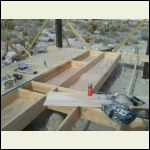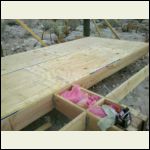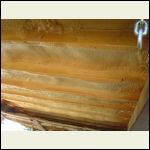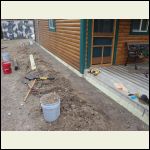|
| Author |
Message |
COTTONPICKER
|
# Posted: 30 Dec 2011 02:55pm
Reply
I plan to build a 16 X 18 cabin as soon as my (3RD) retirement rolls around. I have built several buildings with good results but have little experience with insulating as I build.
Funding is not a problem so I am able to do things properly as I build. I am now trying to find out what is "PROPER".
I plan to use 1/4 in hardware cloth underneath the floor joists to keep out "CRITTERS".
What type solid material should I attach to the under side of the floor joists to hold in the insulation? Should the hardware cloth be attached underneath the floor joists AFTER the solid material is attached?
I plan to use 2 X 8 floor joists. Should the entire cavity be filled in with fiberglas type insulation? My joists will be 24 in OC.
I plan to lay in a sub floor, floor & cover floor with vinyl tile. I think the vinyl tile will make it easier to keep clean.
I have no experience with vapor barrier. At what point should I install a vapor barrier?
Any comments or suggetions would be greatly appreciated.
COTTONPICKER
(Yes, I actually picked MUCHO cotton during the 40s & 50s.)
|
|
Swamphunter
Member
|
# Posted: 30 Dec 2011 03:58pm
Reply
Ive been reading about mouse proofing too, but to be quite honest... no where can I find anyone that says it can be done 100%. I am starting my build in the spring.. I've got most all my leg work done, just waiting for the spring thaw and the snow to go. I think that any ADDITIONAL steps taken at least offers another barrier or obstacle to "deter", but I have my doubts that you'll totally prevent them from getting in. Best bet is to make it unfriendly to them by keeping off hours food storage to nothing more than canned goods... good luck
|
|
MtnDon
Member
|
# Posted: 30 Dec 2011 04:37pm
Reply
Rodent Exclusion Manual link Good info; should be read by all cabin folk
We used 3/8 plywood on the underside of the joists. That has kept the rodents out over three years now. There is a strip along each beam with hardware cloth for venting. Note that much of the readily available hardware cloth can be bitten through by rats as it is not heavy enough.
All the wire and pipe penetrations are sealed, doors and windows tight fitting with a sweep on the bottom of the door. No issues with any vermin getting in at all.
|
|
fthurber
Member
|
# Posted: 30 Dec 2011 06:44pm - Edited by: fthurber
Reply
How about a wood floor? White pine is beautiful and cheap; it will be fine without too much traffic. Your local sawmill should have it. Pine looks great in a cabin. Yellow pine also looks great and is more durable but it is a bit more expensive in my area but if you are in cotton country you should be able to get a good price on it.
As far as vapor barrier I would not bother. But that is just me and I am not a professional builder but remember that houses have been built for centuries without vapor barriers. As far as I can tell with vapor barriers unless everything is perfect they can lead to mold. A house that can breath is not a bad thing....
|
|
toyota_mdt_tech
Member
|
# Posted: 1 Jan 2012 05:56pm
Reply
Quoting: Swamphunter Ive been reading about mouse proofing too, but to be quite honest... no where can I find anyone that says it can be done 100%.
Swamphunter, I did it. But I used a full footing/stemwall. I sealed it tight against even the smallest bugs. Most will use the post type foundation. The 1/4 mesh would be the ticket on the underside. And maybe wrap the post with metal from a stove pipe, keep them from being able to climb up also.
|
|
TomChum
Member
|
# Posted: 2 Jan 2012 12:01am - Edited by: TomChum
Reply
"Mouseproofing %" is simply the % that you prevent entry. In some cases the structure is not feasible to mouseproof. This would be a structue with flaws. In other cases it is the % effort spent on the job.
Once a house is 100% mouseproof then it comes down to how often the doors and windows are open at the moment when a mouse is trying to get in.
Mtn Don, I'd have to see a rat chew thru (steel) hardware cloth, to believe that.
|
|
MtnDon
Member
|
# Posted: 2 Jan 2012 12:58am
Reply
I've not seen it myself but my brother in law is a parks maintenance superintendent in Colorado. He has told me that they have found that they have to use 14 to 18 gauge hardware cloth to prevent Norway rats from chewing through. I believe that is the size mentioned in the manuals I linked to. The most common mesh found in stores around here is 23 gauge. I did find 18 gauge 1/4" mesh at my True Value hardware stores a few back and that's what I have used.
23 gauge = 0.0258"
18 gauge = 0.0475
16 gauge = 0.0625
There's a considerable difference
|
|
jimmer
Member
|
# Posted: 2 Jan 2012 06:08pm
Reply
Mice aside... i'm pretty curious about how the insulation part of the original post -- how to insulate the floor joists.
I'm about to build a platform for a small shack (100 sq feet). I'm thinking some 2x6 or 2x8 joists, 16" OC, covered with ply.
The location (west coast of Vancouver Island) dips down to around freezing occasionally, but not much below.
i'm planning on insulating the walls, and likely the rafters... but do i insulate the flooring?
If so, how? Do i need to build a sub-floor (ie., another layer 6" or so on top of the ply), or do i insulate between the joists or ?
Sorry if i seem daft, I've been scouring for information and can't seem to find much on this...
thanks!
|
|
|
MtnDon
Member
|
# Posted: 2 Jan 2012 06:17pm
Reply
Batts between the joists from underneath works as long as you do something to keep the rodents, etc out of the batts. Hardware cloth, plywood.....
|
|
Martian
Member
|
# Posted: 2 Jan 2012 06:27pm
Reply
There's a lot of ways to insulate the floors. Some if us use fiberglass placed between the joist. Obviously, the wider the joist, the more you can effectively get in. Some cut Styro boards and place them between the joist. Others spray foam. There are many different ideas on insulating the floor; most times the decision is dictated by finances and effectiveness. Sometimes, some of us just want to try something new that pops into our heads. Yep, there are a lot of ways to insulate a floor.
What would you like to know?
Tom
|
|
jimmer
Member
|
# Posted: 2 Jan 2012 06:53pm
Reply
Ahh, hardware cloth or plywood underneath the batts... now, re-reading this thread, things are making a bit more sense!
I guess my last bit of confusion (i'm very new to the building world!) would be from a practical standpoint of how to apply the insulation between the joists from underneath.
I had been thinking I'd build my platform/deck on the ground (into some of those pyramid shaped concrete blocks), lay out the joists, build a frame for it then apply plywood on top. The insulation couldn't go on until the plywood is on top (right?)... so would i then have to tilt the entire structure up on its edge to get at the underside?
Or what am i missing here? Obviously it would be easier if I build the platform a couple feet up in the air, on posts, but I was hoping to avoid that...
thanks again!
|
|
MtnDon
Member
|
# Posted: 2 Jan 2012 07:54pm - Edited by: MtnDon
Reply
Lots of folks get away with installing the insulation in the floor before the sub floor sheathing goes on. They will often have the joists low to the ground and do it that way as they can't crawl underneath to do anything. Personally I don't like that method. One reason is I have seen some who were not very lucky with the weather, being rained on and having water get into the floor insulation.
We used piers that extend 13" above grade. That's still a squeeze unless I go in under the ends. Note: If the bottom of the beams are closer to the ground than 12 inches, the beams should be PT lumber. If the bottom of the floor joists, or plywood under the joists, are closer to the ground than 18" they should also be PT.
You mentioned using plywood for subfloor. You should also have a look for a product called Advantech, made by Huber It has amazing water resistance. Getting rained on a lot plywood can have problems show up much more than Advantech.
Being able to crawl under the cabin could be handy for many reasons at some future time.
On the other hand raising the cabin too much then gets into another realm of possible problems. That is making certain the structure is adequately braced against movement from high winds or possible earthquake. This is quite often inadequately done.
|
|
Just
Member
|
# Posted: 2 Jan 2012 09:54pm
Reply
I built a 8 x 12 6 in off the ground started off up side down 2 x 4 pt. frame 1\4 in pt ply wood then hardware cloth then flip it over and attach to foundation i used 3 ,12 ft . pt. 4 x 4 s sitting on 9 deck blocks on stone base . then put in your insulation add a layer of poly then your subfloor . thats it !!where I come from the hardware cloth must be on the outside as we have porkypines that love to eat plywood .
|
|
jimmer
Member
|
# Posted: 3 Jan 2012 12:03am
Reply
Sounds good, thanks guys!
|
|
COTTONPICKER
|
# Posted: 3 Jan 2012 08:58am
Reply
Thank you all so much for your replies.
Your first hand experiences are like gold to me and are filed away in my memory banks for the time when I begin construction.
Thanks again,
Cotton Picker
(Still slaving away toward my 3rd retirement)
|
|
Borrego
Member
|
# Posted: 3 Jan 2012 06:12pm - Edited by: Borrego
Reply
I stuffed my floor with R-30 and then used ply like Mtn Don underneath the joists. More like 3/16 water resistant luan that I primed first.
I actually tried 2 different ways: putting 1 x 2 strips at the bottom of the joist and then setting the ply on top, the other was just crawling underneath with full sheets and nailing them on. Either way works fine, but you can do the first one by yourself, whereas the full sheets take a couple of helpers (but is way faster)
I think someone on here used LVL (I - Beam joists) and dropped the plywood down onto the existing 'flanges'
Dec_310_002.jpg
| 
Dec_310_010.jpg
|  |  |
|
|
COTTONPICKER
|
# Posted: 4 Jan 2012 11:26am
Reply
Borrego,
Thanks for the info.
I like the way you staggered the plywood.
As I am a "Do it your self" type guy I will probably use your method of attaching a support to the under side of the joists & dropping in plywood support for the insulation.
What thickness plywood did you use for the insulation support?
Thanks again,
Cotton Picker
|
|
Borrego
Member
|
# Posted: 4 Jan 2012 09:48pm
Reply
Quoting: COTTONPICKER What thickness plywood did you use for the insulation support?
About 1/4", no need for any more, just make sure it's sealed tight all around, use gap filler foam or equivalent. Or silicone...
Quoting: COTTONPICKER I like the way you staggered the plywood.
That's how you do it, a full sheet, then a half sheet and so on. I actually ran it the wrong way at first, you should run it long ways to the joists. I think I was drinkin' :-)
|
|
huntervg
Member
|
# Posted: 12 Feb 2021 11:16pm
Reply
I have attic flies come in every fall and stay in the attack and somehow get into the house all year. Any ideas on how to seal the walls and steel roof?
thanks
|
|
gcrank1
Member
|
# Posted: 13 Feb 2021 11:17am
Reply
My '83,'84 12x24' build was 1" exp set on ledger strips 1" down from the top of the joists. Id do it again but look at 2" now.
3/4" decking on top of the 16"oc joists.
I made a very conscious effort as I built up from that to not leave gaps critters might use as a point to start chewing in. We held them at bay for several years but eventually we had mice  . Remember, they make their living out there 24/7. The more you are there and use the place the better the chance of keeping them under control. And a cabin cat can help. . Remember, they make their living out there 24/7. The more you are there and use the place the better the chance of keeping them under control. And a cabin cat can help.
But in the 37ish years we never had mice coming up through the floor.
|
|
ketchgould
Member
|
# Posted: 11 Mar 2021 11:16am
Reply
Wouldn't a concrete slab be a great first step in stopping mice?
Christian
|
|
toyota_mdt_tech
Member
|
# Posted: 17 Mar 2021 07:56am
Reply
Quoting: ketchgould Wouldn't a concrete slab be a great first step in stopping mice?
I would certainly think so.
|
|
Brettny
Member
|
# Posted: 17 Mar 2021 08:05am
Reply
A slab means they just wouldnt chew there way up through the floor. I have never had this happen even in 90yr old buildings. Mice can climb alot of wood siding products and they even got up in the corner bead of my vinyl siding. Theres a whole lot more places for them to get in becids the floor.
I seal up everything I can, use snap traps in the basement and poison outside. Prior to me moving Into my house it was so bad that moce had pissed through the ceiling drywall.
|
|
gcrank1
Member
|
# Posted: 17 Mar 2021 12:51pm
Reply
Mice make their living 24/7 getting into our stuff that we cant spend 24/7 keeping them out of....
Thus the traps, poison and if we were there more, the cat (but then minus the poison).
|
|
NBNK
Member
|
# Posted: 17 Mar 2021 03:16pm - Edited by: NBNK
Reply
Bottom is a spray foam mouse won't chew, rabbits will Rabbits and minks were digging under it so we placed treated 2 x 6 with chicken wire , that was years ago and problem solved.
Underside
| 
Keep diggers out
|  |  |
|
|
|

